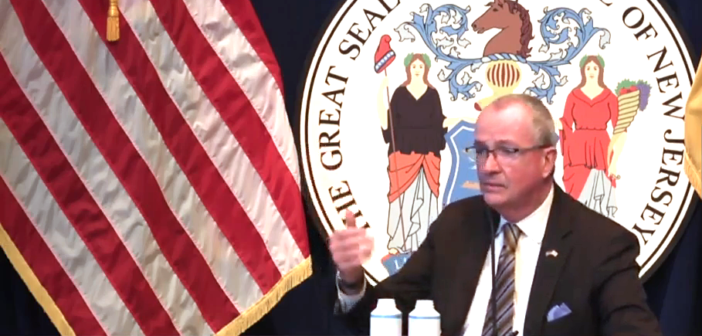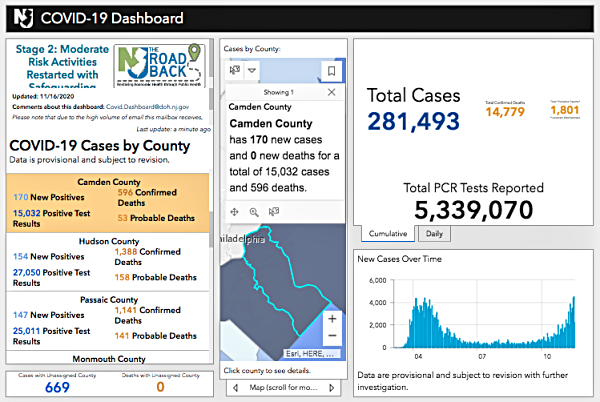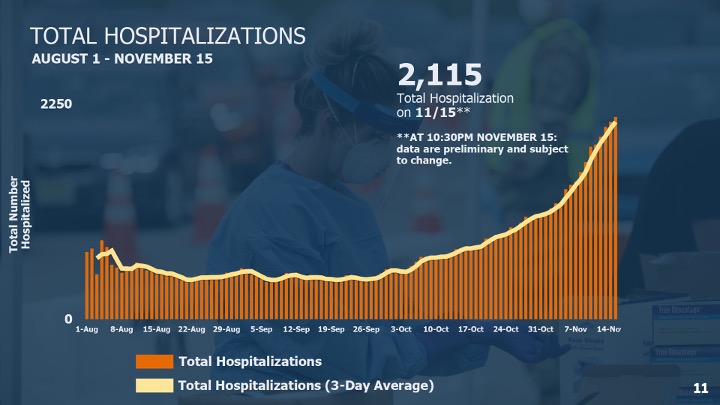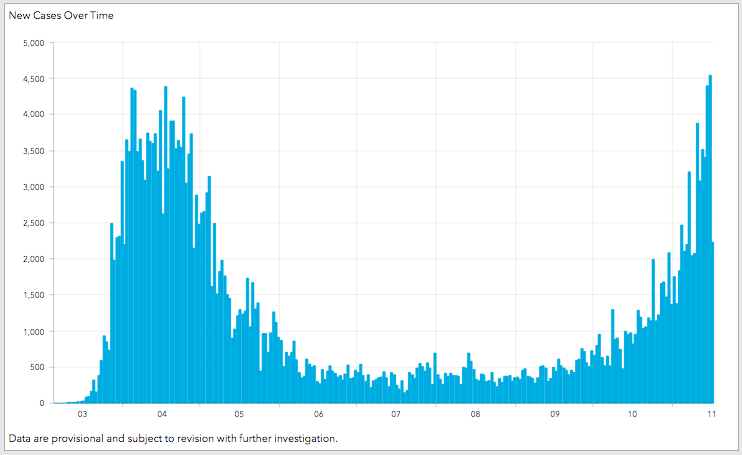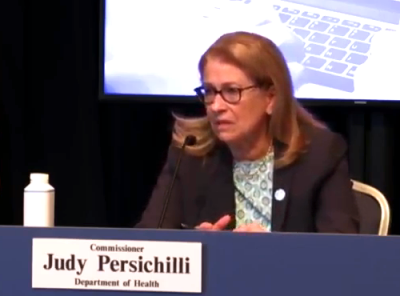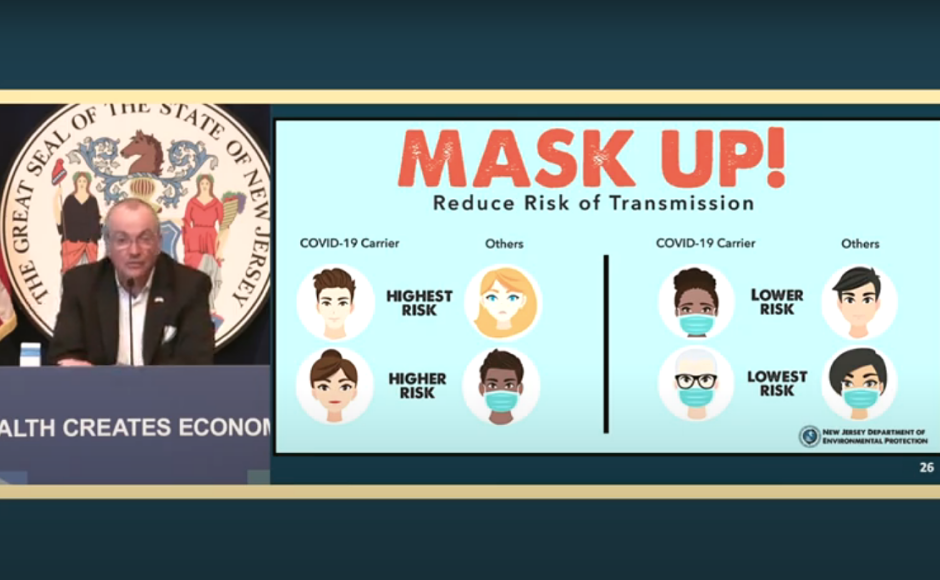One in 20 New Jerseyans testing positive for COVID-19 have done so in the past four days, and the state fears the second surge will eclipse the first without citizens changing their behavior.
Another 2,232 New Jersey residents have tested positive for novel coronavirus (COVID-19), bringing the statewide total to 281,493 cases, Governor Phil Murphy reported Monday.
“Five percent of our entire cumulative total has come in the past four days,” Murphy said, with single-day totals from Sunday and Saturday topping the highest seen in the state since the onset of the pandemic.
“Our highest case counts are now no longer from when this virus first began rampaging across our communities,” Murphy said.
“They have come now, when we are grappling with pandemic fatigue, and when we know people have begun to let their guards down,” he said.
“We have got to get back in front of this virus as best we can right now, so that when a vaccine, or multiple vaccines, are ready for wide-scale distribution, we are in a stronger position for our vaccination program to work,” the governor said.
Sadly, 14 more residents have perished from complications related to the virus, bringing the statewide death toll to 14,779 lives lost during the pandemic. In addition to those lab-confirmed fatalities, the state has acknowledged another 1,801 probable COVID-19-related deaths, one more than in previous totals.
Since March, 444 of every 100,000 New Jersey residents have been hospitalized with COVID-19, and 168 of every 100,000 have died from COVID-19-related complications.
More than 5.39 million polymerase chain reaction (PCR) tests for COVID-19 have been performed statewide, with a 3.18-percent positivity rate per 100,000 residents.
Rate of transmission (Rt) at 1.40, spot positivity higher in South Jersey
The statewide average of COVID-19 spot positivity testing stood at 9.43 percent November 12; in South Jersey, it was higher, at 10.67 percent.
Rt, the variable that describes the seven-day, rolling-average, statewide rate of transmission of new COVID-19 cases, hit 1.40 from samples taken November 14.
An Rt figure greater than 1.0 means that each new COVID-19 patient is infecting more than one other person, on average, and the spread of the virus is increasing.
Since its mid-April COVID-19 spike, the highest reported RT in New Jersey was 1.48, recorded August 1. The lowest was 0.62, recorded June 9.
Hospitalizations match levels last seen in early summer
Throughout New Jersey, 2,115 people currently are hospitalized with a suspected or confirmed case of COVID-19, Murphy said.
Among those hospitalized patients, 417 were in intensive or critical care, and 137 of the ICU and critical-care patients (33 percent) are on ventilators.
Across the state, long-term care (LTC) centers have reported 911 cumulative outbreaks of COVID-19, and 241 are dealing with an active outbreak. LTCs account for 40,993 infected patients and staff in New Jersey, or 15 percent of total cases.
That includes 26,146 residents and 14,847 staffers sickened by the virus, as well as 7,252 lab-confirmed resident and staff deaths (48 percent of the statewide total), with facilities self-reporting 122 staff deaths.
Of 656 veterans residing in three state-run homes, 400 residents have tested positive for COVID-19, and 146 have died from complications related to the virus. Four veterans presently are hospitalized with COVID-19, and 250 have recovered from the virus.
At state-run psychiatric facilities, 255 of 1,172 patients and 596 staff members have tested positive for COVID-19. Fourteen patients and seven staffers have died from complications related to the virus.
To date, 61 New Jersey children aged 1 to 18 have been diagnosed with pediatric multisystem inflammatory syndrome, New Jersey Health Commissioner Judy Persichilli said.
All those pediatric patients have tested positive for an active COVID-19 infection or the presence of COVID-19 antibodies, indicating exposure to the virus. No deaths have been associated with this syndrome in New Jersey, although several children have been hospitalized during their treatment.
Since August 1, 51 COVID-19 outbreaks encompassing 193 individual cases have been traced to schools in 18 New Jersey counties. In Camden County, nine outbreaks have been linked to 54 cases. That’s the most in the state.
Gathering limits rolled back as state hits new single-day case totals
Starting Tuesday at 6 a.m., the state returns to capacity limits last seen August 3, in an effort to combat the high inter-personal transmission rates during the latest surge in new cases.
Indoor gathering limits will now be rolled back from 25 to a maximum of 10 people, and outdoor gathering limits are capped at no more than 150 people.
Some exemptions include: religious services, political activities, weddings, funerals and memorials, and performances, all of which may remain at 25 percent of venue capacity, or a 150–person maximum. Indoor sporting events may exceed the 10-person cap only to reach the number of individuals necessary for competition (and excluding spectators). See the language of the executive order here.
“Sports generally is an area of concern,” Murphy said, adding that health officials are struggling to differentiate whether cases are being spread through competitions and practices or through related team activities, including interactions in locker rooms or parties.
“Very specifically, hockey is in our crosshairs,” the governor said, citing anecdotal “non-cooperation” from hockey families reached by contact tracers.
“We’re sick and tired of hearing this,” Murphy said. “We reserve the right to take more drastic action, and if we don’t get better cooperation and better compliance, we will.”
COVID-19 “is a reality in every part of our state,” the governor said, adding that “where we see transmission, we’re taking action, and we’ll continue to do that.”
Residents urged to keep Thanksgiving gatherings limited or virtual
With heightened risks of indoor transmission behind the latest surge in new cases, New Jerseyans are asked to take special precautions not to gather outside of their immediate households during the holidays.
Persichilli reviewed guidance from the U.S. Centers for Disease Control (CDC), which has made the following recommendations for the holiday:
- Celebrate with members of immediate households
- Remain at least six feet apart at all times
- Ask guests to avoid contact with people outside of their households before gathering
- Avoid direct contact with others outside their household
- Host outdoors rather than indoors, and require masks when not eating or drinking
- Increase ventilation by opening windows and doors, placing HVAC on continuous circulation
- Provide attendees with extra masks, sanitizer, tissues, soap, single-use towels
- Limit contact with commonly touched surfaces
- Avoid singing or shouting, and keep music levels down so people don’t have to speak loudly to be heard
“We cannot let our guard down, because we know that gatherings provide an opportunity for COVID-19 to spread,” the commissioner said.
Long-term care centers should plan to accommodate expanded telecommunication options, the commissioner said, with a reminder that residents who leave facilities must be quarantined in isolation for 14 days upon their return.
LTCs also should estimate how many residents can be cohorted through December 31, and create a reservation process for residents who want to leave and visit families for the holidays. (Complete LTC guidance from the Department of Health can be found here.)
Every expansion of in-person gathering limits has led to an uptick in cases followed by new hospitalizations, Persichilli said. She expects that Thanksgiving will be no different.
“The recovery happens very quickly, and we go back to a steady state [of new cases],” she said. “Those recoveries are now longer. We expect after Thanksgiving a tick up, but unfortunately, because of the community spread, the recovery is going to be longer.”
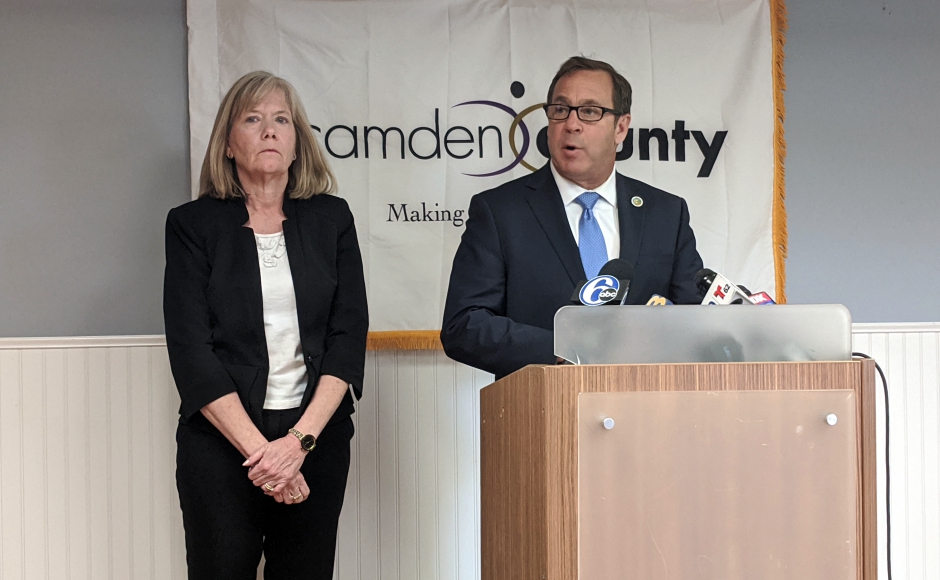
File photo – Camden County Health Department Director Anne Walters and Freeholder Director Lou Cappelli. Credit: Matt Skoufalos.
In a statement issued Monday, Camden County Freeholder-Director Louis Cappelli echoed Persichilli’s remarks.
“This is not our first pandemic holiday,” he said.
“On Easter Sunday, Camden County was averaging 99 new confirmed positive cases of COVID-19 each day.
“One week later, the average had increased 9 percent, to 108 cases per day,” Cappelli said.
“On July 4, we averaged just 25 cases. One week later, a 48-percent increase to 37 cases per day. On Halloween, we averaged 86; one week later, a 74-percent increase to 150,” he said.
“We have seen again and again during this pandemic that when we try to steal a reprieve from the coronavirus by gathering with family and friends, it only tightens its grip on our community,” Cappelli said. “We cannot afford a similar tightening this time, with our cases already at record levels and our hospitals working tirelessly to keep beds open and keep sick people alive.”
Improved compliance with public health guidance can shorten the anticipated peak of the second wave of the virus from early 2021 to end-2020, Persichilli said, but not without redoubled efforts from the bulk of the population.
“The most important part of our predictive modeling is behaviors,” she said.
Earlier in 2020, epidemiological predictions estimated that 31 percent of the population would comply with guidance; in reality, an estimated 50 percent did.
Were New Jersey to return to those numbers, the second wave could peak at the end of the year, leading to “a very busy January and February, but not as high as it was in April,” Persichilli said.
“If people are not vigilant, it could be worse,” she said, forecasting peaks of more than 8,300 COVID-19-related hospitalizations, and 2,300 critical care patients.
“Each one of us, our behaviors, can manage that,” she said.
Residents “did it, and we have to do it again,” Murphy said, urging residents to tamp down “some bad behavior and some myths… that we didn’t have in the spring.”
“We’re talking about six months here, but it’s right here, right now,” he said.
Read our ongoing round-up of COVID-19 coverage here.
Please support NJ Pen with a subscription. Get e-mails, or follow us on Facebook, Twitter, and Instagram.

